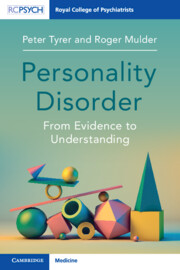Book contents
- Personality Disorder
- Personality Disorder
- Copyright page
- Dedication
- Contents
- Foreword
- Acknowledgements
- Chapter 1 History of Personality and Its Disorders
- Chapter 2 Assessment of Personality
- Chapter 3 Personality Difficulty
- Chapter 4 Borderline Personality Disorder
- Chapter 5 Cultural Perspectives
- Chapter 6 Personality and Health
- Chapter 7 Personality Disorders and Comorbidity with Other Mental Illness
- Chapter 8 Treatment and Outcome of Personality Disorder
- Chapter 9 Moderating the Stigma of Personality Disorder
- Chapter 10 What Needs to Be Done Now
- Appendices
- References
- Index
Chapter 4 - Borderline Personality Disorder
A Condition That Appeared Without Trace
Published online by Cambridge University Press: 04 February 2022
- Personality Disorder
- Personality Disorder
- Copyright page
- Dedication
- Contents
- Foreword
- Acknowledgements
- Chapter 1 History of Personality and Its Disorders
- Chapter 2 Assessment of Personality
- Chapter 3 Personality Difficulty
- Chapter 4 Borderline Personality Disorder
- Chapter 5 Cultural Perspectives
- Chapter 6 Personality and Health
- Chapter 7 Personality Disorders and Comorbidity with Other Mental Illness
- Chapter 8 Treatment and Outcome of Personality Disorder
- Chapter 9 Moderating the Stigma of Personality Disorder
- Chapter 10 What Needs to Be Done Now
- Appendices
- References
- Index
Summary
Borderline Personality Disorder (BPD) is the most prominent and well recognised of all current personality disorder (PD) categories. However, it has not always been this way. In fact, the ‘borderline patient’ is one of the newer categories in personality classification. The term emerged, largely in North America, in the 1950s. While most ‘psychopathic’ personality types have been recognised in one form or another since the nineteenth century, borderline has not. Schneider’s (see Chapter 1) classification, which formed much of the basis for the DSM II and ICD 9 classification of personality, describes an ‘emotionally unstable personality’, but this is largely related to unstable mood and better translated as ‘with labile mood’ (Stimmungslabile). ‘Explosive personality’ shares some features with BPD but these are confined to disinhibition. Kraepelin expanded pathological personalities to seven types in the eighth edition (1909–15) of his textbook, but only one – ‘The Excitable’ (die Erregbaren) – has any overlap with BPD.
- Type
- Chapter
- Information
- Personality DisorderFrom Evidence to Understanding, pp. 31 - 38Publisher: Cambridge University PressPrint publication year: 2022



